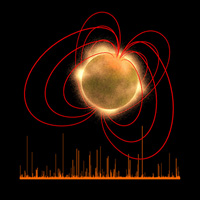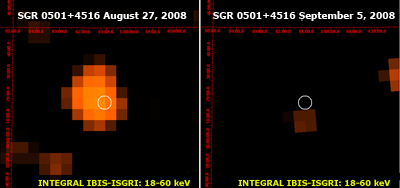At last! After 10 years a new Soft Gamma Repeater is observed
16 June 2009
Detailed observations of the first new Soft Gamma Repeater in 10 years strengthen the unified view of the magnetar phenomenon; the INTEGRAL and XMM-Newton target of opportunity programmes played a fundamental role in obtaining these successful observations of SGR 0501+4516. This is reported by Nanda Rea and colleagues in an article in the MNRAS published online on 15 June 2009.
 |
|
Illustration of a magnetar. Credit: NASA |
These sources are not active all the time, but rather undergo periods of significantly increased activity when their emission can be up to 100 times stronger than normal. Besides making the sources easier to see, these outbursts are related to interesting physical phenomena, and thereby are key to understanding how these objects work. Since these outbursts can wane in a matter of hours, it is crucial to observe them as quickly as possible, while the source is still bright.
Observing a rare outburst is a challenge
The time and location of the outbursts cannot be predicted, so detecting these events can be challenging. Fortunately, many high-energy satellites have been equipped with wide-field burst monitors. These monitors can view about 10% of the entire sky at one time, while the main instruments concentrate on pointed observations with a field of view of a few minutes of arc. A burst monitor's main task is to detect a sudden increase in the X-ray emission over a broad energy range and quickly (within several seconds) calculate its position within a few minutes of arc, allowing the narrow-field instruments to perform more detailed observations. An international network has been established for the exchange of information about newly discovered bursts, so that all interested parties may perform valuable follow-up observations.
While performing a follow-up observation with a ground-based telescope is a rather uncomplicated affair, quickly re-pointing a space-borne observatory needs more planning. XMM-Newton and INTEGRAL have established Target of Opportunity programmes in order to quickly respond to burst announcements, and a clear procedure has been established whereby the Project Scientist can decide whether or not the current observation can be interrupted.
A new Soft Gamma Repeater is detected
On 22 August 2008 a burst alert originating from NASA's Swift spacecraft hit the wires: a new Soft Gamma Repeater, the first in 10 years, had just become active. Rea and colleagues immediately requested to perform a Target-of-Opportunity observation with XMM-Newton and INTEGRAL. The request was granted, and from 15 hours after the trigger until a few weeks later, both ESA observatories were observing the new burst unfold. This extended period of observation allowed the scientists to follow the evolution of this object in great detail.
ToO observations provide unique insight
The XMM-Newton observations, taken while the source's emission was still very intense, allow the scientists to investigate the temporal and spectral behaviour of this object in great detail.
The timing analysis of the data reveals that the source's rotation rate is decreasing with time, and that the rate of slow down is also decreasing with time, suggesting that the object is recovering its pre-burst rotation period.
The INTEGRAL data show that a higher energy component was present early on (1-2 days after the start of the outburst), but quickly fell below threshold, the first such observation for a magnetar.
 |
|
Transient high energy X-ray emission as observed by INTEGRAL. Credit: ESA/INTEGRAL/IBIS-SIGRI (Rea et al. 2009) |
More importantly, the detailed spectral analysis of the XMM-Newton data reveals that some features of SGR 0501+4516 are at odds with the conventional SGR behaviour. Although this source exhibited the typical strong bursting behaviour expected of SGRs, its energy spectrum is significantly steeper than expected, rather more like an Anomalous X-ray Pulsar (another type of magnetar).
Observations support unified view of magnetars
Rea and colleagues note that this unexpected behaviour makes this SGR more like an AXP; on the other hand, they note, recent observations of the AXP 1E 1547.0-5408 reveal that this object exhibits SGR-like features.
The authors conclude that this is further evidence that the two classes in which magnetars have been classified until now should be reconsidered, and that all these objects should be regarded as a general magnetar class of objects.
Related publication:
Rea, N. et al., "The first outburst of the new magnetar candidate SGR 0501+4516", to appear in MNRAS. (Published online 15 June 2009.) DOI:10.1111/j.1365-2966.2009.14920.x

